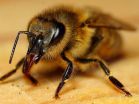(Press-News.org) CHAMPAIGN, Ill. — Scientists report they can crank up insect aggression simply by interfering with a basic metabolic pathway in the insect brain. Their study, of fruit flies and honey bees, shows a direct, causal link between brain metabolism (how the brain generates the energy it needs to function) and aggression.
The team reports its findings in the Proceedings of the National Academy of Sciences.
The new research follows up on previous work from the laboratory of University of Illinois entomology professor and Institute for Genomic Biology director Gene Robinson, who also led the new analysis. When he and his colleagues looked at brain gene activity in honey bees after they had faced down an intruder, the team found that some metabolic genes were suppressed. These genes play a key role in the most efficient type of energy generation in cells, a process called oxidative phosphorylation.
"It was a counterintuitive finding because these genes were down-regulated," Robinson said. "You tend to think of aggression as requiring more energy, not less."
In the new study, postdoctoral researcher Clare Rittschof used drugs to suppress key steps in oxidative phosphorylation in the bee brains. She saw that aggression increased in the drugged bees in a dose-responsive manner, Robinson said. But the drugs had no effect on chronically stressed bees – they were not able to increase their aggression in response to an intruder. (Watch a video of honey bees responding to an intruder.)
"Something about chronic stress changed their response to the drug, which is a fascinating finding in and of itself," Robinson said. "We want to know just how this experience gets under their skin to affect their brain."
In separate experiments, postdoctoral researcher Hongmei Li-Byarlay and undergraduate student Jonathan Massey found that reduced oxidative phosphorylation in fruit flies also increased aggression. Using advanced fly genetics, the team found this effect only when oxidative phosphorylation was reduced in neurons, but not in neighboring cells known as glia. This result, too, was surprising, since "glia are metabolically very active, and are the energy storehouses of the brain," Robinson said.
The findings offer insight into the immediate and longer-term changes that occur in response to threats, Robinson said.
"When an animal faces a threat, it has an immediate aggressive response, within seconds," Robinson said. But changes in brain metabolism take much longer and cannot account for this immediate response, he said. Such changes likely make individuals more vigilant to subsequent threats.
"This makes good sense in an ecological sense," Robinson said, "because threats often come in bunches."
The fact that the researchers observed these effects in two species that diverged 300 million years ago makes the findings even more compelling, Robinson said.
"Because fruit flies and honey bees are separated by 300 million years of evolution, this is a very robust and well-conserved mechanism," he said.
INFORMATION:
The National Science Foundation supported this work.
Editor's notes: To reach Gene Robinson, call 217-265-0309; email generobi@illinois.edu.
The paper, "Socially responsive effects of brain oxidative metabolism on aggression," is available online or from the U. of I. News Bureau.
Researchers boost insect aggression by altering brain metabolism
2014-08-05
ELSE PRESS RELEASES FROM THIS DATE:
This week from AGU: Sea-level spikes, volcanic risk, volcanos cause drought
2014-08-05
From AGU's blogs: Sea-level spikes can harm beaches worse than hurricane
Unforeseen, short-term increases in sea level caused by strong winds, pressure changes and fluctuating ocean currents can cause more damage to beaches on the East Coast over the course of a year than a powerful hurricane making landfall, according to a new study. The new research suggests that these sea-level anomalies could be more of a threat to coastal homes and businesses than previously thought, and could become higher and more frequent as a result of climate change, according to a new study ...
Biology made simpler with clear tissues
2014-08-05
In general, our knowledge of biology—and much of science in general—is limited by our ability to actually see things. Researchers who study developmental problems and disease, in particular, are often limited by their inability to look inside an organism to figure out exactly what went wrong and when.
Now, thanks to techniques developed at Caltech, scientists can see through tissues, organs, and even an entire body. The techniques offer new insight into the cell-by-cell makeup of organisms—and the promise of novel diagnostic medical applications.
"Large volumes of tissue ...
Researchers uncover novel process for creation of fuel and chemical compounds
2014-08-05
MADISON, Wis. — A team of researchers at the University of Wisconsin-Madison has identified the genes and enzymes that create a promising compound — the 19 carbon furan-containing fatty acid (19Fu-FA). The compound has a variety of potential uses as a biological alternative for compounds currently derived from fossil fuels.
Researchers from the Great Lakes Bioenergy Research Center (GLBRC), which is headquartered at UW-Madison and funded by the U.S. Department of Energy, discovered the cellular genomes that direct 19Fu-FA's synthesis and published the new findings Aug. ...
Baby aspirin? Many doctors don't recommend, despite guidelines
2014-08-05
A majority of middle-aged men and women eligible to take aspirin to prevent heart attack and stroke do not recall their doctors ever telling them to do so, according to a University of Rochester study of a national sample of more than 3,000 patients.
Published online by the Journal of General Internal Medicine, the finding illustrates a common disconnect between public health guidelines and what occurs in clinical practice. The UR study is consistent with other research showing that physicians often do not recommend aspirin as prevention therapy to the general population, ...
Pistachios may lower vascular response to stress in type 2 diabetes
2014-08-05
Among people with type 2 diabetes, eating pistachios may reduce the body's response to the stresses of everyday life, according to Penn State researchers.
"In adults with diabetes, two servings of pistachios per day lowered vascular constriction during stress and improved neural control of the heart," said Sheila G. West, professor of biobehavioral health and nutritional sciences. "Although nuts are high in fat, they contain good fats, fiber, potassium and antioxidants. Given the high risk of heart disease in people with diabetes, nuts are an important component of a ...
Watching chemistry in motion: Chemical environments mapped using molecular vibrations
2014-08-05
Scientists have long known that a molecule's behavior depends on its environment. Taking advantage of this phenomenon, a group of researchers at the University of Chicago developed a new technique to map microscopic environments using the vibrations of molecules.
"It's a special new advance that will be broadly useful in studies of molecular and materials phenomena," said Andrei Tokmakoff, the Henry G. Gale Distinguished Service Professor in Chemistry at UChicago. He and two of his associates report their new technique in a paper published online in the journal Optics ...
Physicists eye neural fly data, find formula for Zipf's law
2014-08-05
Physicists have identified a mechanism that may help explain Zipf's law – a unique pattern of behavior found in disparate systems, including complex biological ones. The journal Physical Review Letters is publishing their mathematical models, which demonstrate how Zipf's law naturally arises when a sufficient number of units react to a hidden variable in a system.
"We've discovered a method that produces Zipf's law without fine-tuning and with very few assumptions," says Ilya Nemenman, a biophysicist at Emory University and one of the authors of the research.
The ...
'Treatments waiting to be discovered' inside new database
2014-08-05
Your genes are blueprints for proteins, and molecules called microRNA can help to determine how often these genetic blueprints are manufactured into proteins. Researchers often ask what microRNA regulates a gene related to disease. Or what gene is regulated by a microRNA found in sick patients? The answers to these questions could help doctors and researchers manipulate protein levels in the body that cause disease, especially cancer. A University of Colorado Cancer Center study recently published in the top-ranked journal Nucleic Acids Research (NAR) describes a database ...
Monthly preventative treatment with a new drug combination reduces malaria in children
2014-08-05
Preventative treatment with a monthly dose of a newer antimalarial drug can reduce the risk of malarial infection among young children, according to a study published in this week's PLOS Medicine. The study, conducted by Victor Bigira and colleagues at San Francisco General Hospital and the Makerere University College of Health Sciences in Kampala, Uganda, finds that treating young children with dihydroartemisinin-piperaquine (DP) decreased their risk of contracting malaria.
Preventative treatment of malaria is a useful strategy to protect young children in Africa, but ...
Pregnant women are often given inappropriate treatment for malaria
2014-08-05
Not all pregnant women with symptoms of malaria seek care from their formal healthcare system and if they do seek care, they may be given inappropriate treatment because healthcare providers often fail to adhere to the standard (World Health Organization-WHO) diagnostic and treatment guidelines, according to a study by UK researchers published in this week's PLOS Medicine.
The authors (led by Jenny Hill from the Liverpool School of Tropical Medicine) reached these conclusions by reviewing all relevant studies that investigated the factors that affect pregnant women's ...


